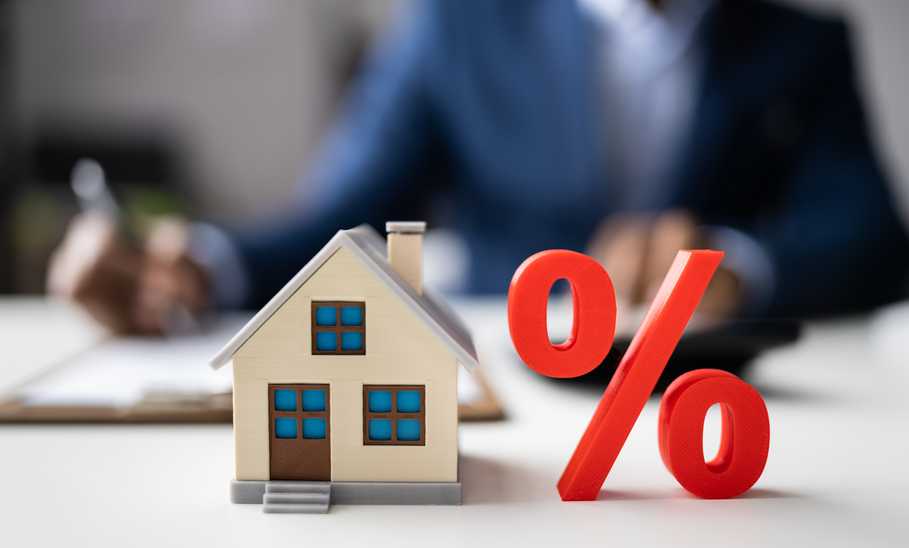What Is the Ideal Percentage of Income for Mortgage Payments?

Our evaluations and opinions are not influenced by our advertising relationships, but we may earn a commission from our partners’ links. This content is created by TIME Stamped, under TIME’s direction and produced in accordance with TIME’s editorial guidelines and overseen by TIME’s editorial staff. Learn more about it.
Whether you're buying your first home or starting the search for your dream home, the experience of purchasing a home is bound to be a costly one. Like it or not, there are a myriad of expenses that go into purchasing a house, and some of them are beyond your control. For example, your monthly mortgage payment will depend on not just the price of your home, but also your down payment amount and on whether you qualify for the best mortgage rates.
That said, your ability to get the house you want will also hinge on your income. In fact, mortgage companies typically only allow your housing payment to make up a certain percentage of your gross income each month, and this factor can limit your purchasing power by quite a bit.
Of course, other debts you have can also impact the percentage of your income that should go to a mortgage as well. This guide will break down everything you need to know about affording a mortgage for a home in your preferred price range, including common rules of thumb to keep in mind.
First off, you should know about all the different costs that go into a typical mortgage payment, and that these expenses aren't just limited to principal payments and interest. Here's a rundown of everything that may be included in your housing payment once you close on a home purchase.
While mortgage companies have their own rules that limit how much you can borrow based on your income and other factors, you should probably set a few limits of your own. After all, having a housing payment that's more than it should be can make it difficult to save money while living the type of lifestyle you want.
As you look at these common rules of thumb, you should also know the difference between front-end ratio and back-end ratio. Where the term "front-end ratio" is used to describe your monthly housing payment and all it entails (e.g., principal, interest, taxes, and insurance), the term "back-end ratio" takes all of your other debts into account. For example, your back-end ratio can include your monthly auto payment, credit card payments, student loan bills, and other payments you have to make each month.
Common percentage of income rules for housing payments include the following:
The most common rule for housing payments states that you shouldn't spend more than 28% of your gross income on your housing payment, and this should account for every element of your home loan (e.g., principal, interest, taxes, and insurance). If you and your spouse earn $10,000 per month gross, for example, your full housing payment should be no more than $2,800. If your gross income is half of that, or $5,000 per month, your monthly housing payment should be no more than $1,400.
The 28% / 36% rule is the same as the 28% rule when it comes to your housing payment, but it also considers your back-end ratio. With this rule, housing costs should not make up more than 28% of your gross income, and no more than 36% of your gross income should be required to meet all your monthly debt obligations combined.
Using this rule, having a gross income of $10,000 means your monthly housing payment should be no more than $2,800, and that your total debts each month should be no more than $3,600. With a gross monthly income of $8,000, your monthly housing payment should be no more than $2,240, and your total debts each month should be no more than $2,880.
The 35% / 45% rule is another housing payment rule that considers your gross monthly income, yet it also takes your post-tax income into account. Essentially, this housing payment rule says your housing payment shouldn't be more than 35% of your gross income or more than 45% of your net income after you pay taxes.
Let's say your gross monthly income is around $8,000, but that you actually bring home around $6,500 after income taxes are taken out. With this rule, your housing payment should be no more than 35% of your gross monthly income (no more than $2,800) but also no more than 45% of your post-tax monthly income (no more than $2,925).
Finally, some homebuyers prefer to use their after-tax income only, which is easy to figure out by looking at your paychecks and adding them up for any given month. The 25% post-tax rule says no more than 25% of your post-tax income should go toward housing costs.
If you bring home $2,000 per week in your paycheck, or $8,000 per month, this means your full housing payment should be no more than $2,000.
While the percentage of income rules we outlined above are common for homebuyers to use, every lender has their own set of requirements to determine eligibility. The type of home loan you apply for may also impact some of these factors as well.
For the most part, mortgage lenders consider the following criteria when you apply for financing:
Regardless of which home price range you're shopping in, there are several steps you can take to lower your monthly mortgage payment. You may even be able to take several of these steps at the same time to score a much lower housing payment than you would otherwise pay.
Boosting your credit score can open the door to a wider variety of loan types you may be eligible for. While a minimum credit score of 620 is helpful if you want a conventional home loan, it's worth noting that you may get the best mortgage rates if you boost your score up from there.
As an example, having a "very good" FICO score of 740 to 799 can help you score a lower rate, and so can an "exceptional" FICO score of 800+.
Use one of the best savings accounts to begin saving up a bigger down payment than you planned to. You can also begin saving up your down payment in a certificate of deposit (CD), and now is a good time to do so since we're seeing some of the best CD rates we have seen in the last five years.
Compare the best savings accounts
Either way, the Consumer Financial Protection Bureau (CFPB) points out that saving up a down payment of at least 20% for a conventional loan can help you avoid paying private mortgage insurance (PMI). A bigger down payment also leads to a lower mortgage amount and a lower monthly housing payment as a result.
If you don't mind paying off your home loan over a longer term, choosing a lengthier home loan from one of the best banks can leave you with a lower monthly payment. This step can mean choosing a 30-year fixed rate mortgage over a 15-year home loan or a 20-year loan. However, it could also mean choosing an adjustable-rate mortgage (ARM) over a fixed-rate loan in order to take advantage of a low teaser interest rate for several years.
Either way, it's worth noting that you can always refinance your mortgage to switch up your loan term again later on.
Also remember that a lot more goes into buying a home than just your monthly housing payment. There are upfront home purchase expenses to consider, just as there are costs involved in buying a home and expenses that result from being a homeowner for years to come.
Here's a rundown of just some of the expenses you'll want to keep in mind before, during, and after the homebuying process:
| Pre-mortgage costs to consider | Post-mortgage costs to consider |
|---|---|
Savings for a down payment | Regular maintenance and upkeep |
Costs for home inspection | Replacement of major components (e.g. roof, HVAC system, water heater) |
Mortgage closing costs | Lawn care and landscaping |
Prepaid costs at closing (property taxes, homeowners insurance, etc.) | Home improvements and projects |
Moving and relocation expenses | Furniture, window coverings and decor |
In most cases, you'll need to save up at least 3% to 5% as a down payment for a home. To calculate how much you need, you'll take the home purchase price and multiply it by the percentage you need to save up. As an example, let's say you want to purchase a $300,000 home and you plan to get a FHA home loan that requires a 3.5% down payment. In that case, you would multiply $300,000 by 0.035 and wind up with a down payment amount of $10,500.
FHA loans require a minimum down payment of 3.5% if your credit score is above 580. If you have a credit score between 500 and 579, however, you will likely need to save up a down payment of 10% of the home value.
USDA loans offer the chance for 100% financing, meaning you may not need a down payment. From there, your monthly housing payment will depend on your mortgage interest rate and loan amount.
VA loans offer the chance for 100% financing, meaning you may not need a down payment. Similar to USDA loans, the mortgage payment on a VA loan depends on the interest rate and the loan amount.
Your eligibility for a mortgage depends on a number of factors that can vary by loan type. However, you may be able to qualify for a conventional mortgage with a debt-to-income ratio as high as 50%.
Choose from a wide range of home loans, including conventional mortgages, FHA loans, VA loans, USDA loans for rural housing, and more.
The information presented here is created by TIME Stamped and overseen by TIME editorial staff. To learn more, see our About Us page.



